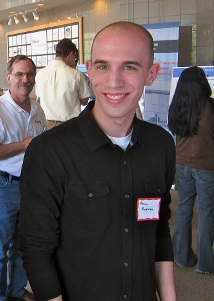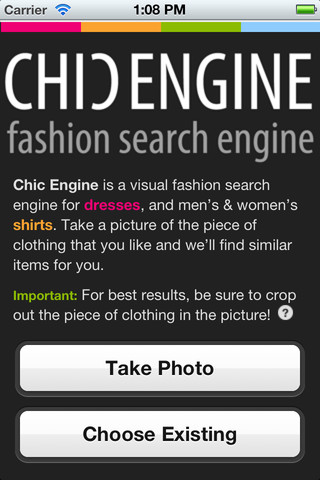Fashion Forward
 Chic Engine, a website and iPhone app created by Computer Science Ph.D. student Adrian Rosebrock helps you find clothes you see on friends, strangers, or online. Just snap a photo, and let Chic Engine do the rest.
Chic Engine, a website and iPhone app created by Computer Science Ph.D. student Adrian Rosebrock helps you find clothes you see on friends, strangers, or online. Just snap a photo, and let Chic Engine do the rest.
CSEE: Tell us about your “ah-ha” moment with Chic Engine. What inspired you to start it?
Adrian: It is really interesting how common, everyday conversation illuminates problems that many of us encounter in day-to-day life. I always try to pay attention to these types of problems because if you can provide a solution to them, your product could be adopted by a widespread community of users.
The inspiration for Chic Engine came from these types of everyday conversations. I always see people turn to their friends and say “I love your dress, where did you get it?” Normally, their friend can provide an answer. However, what happens if this person is not your friend and is instead a stranger walking down the street? What if you aren’t looking at a person, but instead a magazine ad or a poster of the latest GQ outside the subway? How do you find your answer?
Chic Engine, in short, is an answer to the question “Where did you get that dress?” or “Where can I find more dresses such as this one?” Given a picture, Chic Engine analyzes it, extracts the piece of clothing from it, and then returns similar results.
CSEE: What does Chic Engine do?
Adrian: Chic Engine is a visual fashion search engine. You can either upload a picture to the website or use the iPhone app to take a picture of a piece of clothing that you are interested in. Chic Engine automatically analyzes the image and then returns results with similar clothing items.
The most important facet of Chic Engine is that it does not use “keywords” as you do with other search engines such as Google or Bing. We are no longer describing clothing in terms of words, we are describing them in terms of images. All you need is an example image of clothing that you are interested in—Chic Engine will do the rest.
CSEE: Can you explain how the website works in a technical sense?
The first thing Chic Engine needs is a query image that contains clothing that you are interested in. Once you give it that image (either by uploading it or using the iPhone app), it first extracts the clothing from the image. This process is called background subtraction. We only want to describe the clothing contained in the image, not the surrounding area.
After the clothing is extracted, it is described. In essence, the “description” is Just a list of numbers used to represent the clothing in the image.
However, these lists of number can be quite large, making the search process slow. We want to make our search process as fast as possible to satisfy our users so we must then apply some dimensionality reduction techniques to make the list of numbers more compact.
Lastly, using the compacted list of numbers, we can search against our database of images and find the most similar items.
CSEE: Which online stores does Chic Engine search within?
Adrian: Chic Engine searches many different stores. A sample of the stores include Armani, Neiman Marcus, Banana Republic, Alexander Wang, and Piperlime, to name a few. Almost all major stores are included.
CSEE: Would you consider yourself a fashion junkie? Where do you like to shop?
I am not going to lie. It is pretty rare that I miss an episode of Project Runway, so I guess that does make me a fashion junkie. I enjoy fashion, I enjoy shopping, I enjoy the entire process. Similar to architecture, fashion can be considered art, both of which intrigue me.
As for where I shop, my two go-to places as of late have been Armani and Express. But, at the same time, you can find some real gems in a thrift store while paying next to nothing.
 CSEE: Have you ever used Chic Engine to find new clothes?
CSEE: Have you ever used Chic Engine to find new clothes?
Of course. I am a big believer in using your own product. Someone who builds a product and does not use it themselves likely does not understand the intimate details of the problem they are solving.
Furthermore, if you never use your product you cannot find its shortcomings and find ways to improve it. So yes, I use Chic Engine all the time.
CSEE: How is the iPhone application different from the website?
The iPhone app is essentially a mobile version of the website. In fact, I think the app is better than the website. Having the ability to snap a picture of a piece of clothing, whether it is someone walking past you on the street or in a retail store, and then immediately have similar search results is huge.
Using the iPhone app also relieves some of the user education related problems of the website. The average website user might not understand how to upload an image from their computer or copy and paste the URL of an image they like. The app solves all these problems because all they need to know how to do is take a photo. After the photo is taken, the app can handle the upload and return similar results.
The iPhone app has been downloaded 400+ times at this point*, showing that people are interested in the product. I would also like to make a version for Android users. There is no reason why they should be left out.
CSEE: Do you have any upcoming plans for the website and app? What would your ideal product do?
We recently pushed an update online that allows user to create accounts and save their searches. With search engines such as Google and Bing, it is simple enough to reenter our search query whenever we want to see the results again, but when you are dealing with images, it is more tedious. This functionality is not included in the app, so we plan to update it so users can save their mobile searches for viewing at a later date. The next version of the app will also continue to improve on user-friendliness.
The ideal app would include as many stores as possible and it would learn from what the user uploads. It would be able to model the taste of the user, and then based on the model, it would return even more relevant search results.
At this point, Chic Engine has been online four months*. It has come a long way since it was first published online, but there are still a lot of challenging problems to overcome. Overall, I think it shows great promise and I love working on it.
*Adrian was interviewed in July 2012.